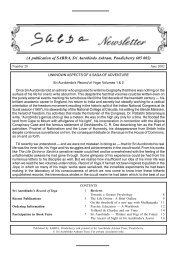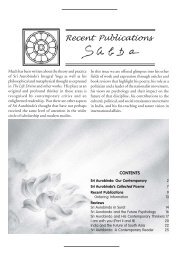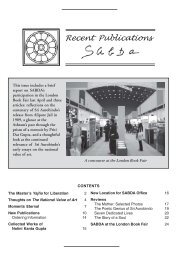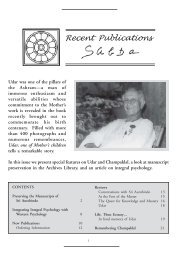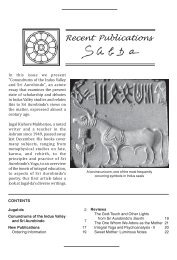November 2010 - Sabda - Sri Aurobindo Ashram
November 2010 - Sabda - Sri Aurobindo Ashram
November 2010 - Sabda - Sri Aurobindo Ashram
You also want an ePaper? Increase the reach of your titles
YUMPU automatically turns print PDFs into web optimized ePapers that Google loves.
of the Gita, shloka by shloka, in <strong>Sri</strong> <strong>Aurobindo</strong>’s words.<br />
Reading it is compulsive, educating, and highly<br />
satisfying. The translation touches the marrow of the<br />
seeker’s sensibility. An understanding of the Gita<br />
becomes so clear that the inward journey begins at<br />
once, very naturally and effortlessly. This book is a<br />
must for all who love the Gita, all who love <strong>Sri</strong><br />
<strong>Aurobindo</strong> and India, and all who love spirituality:<br />
the SanDtana Dharma.<br />
The value of this book cannot be described or explained<br />
in a mere 1600-word book review. One must study it<br />
to be able to experience the grandeur and the beauty of<br />
the Gita’s teaching in English. It is poetry in prose; it<br />
is philosophy at its highest; it is spiritual thought<br />
materialised. It will remain your companion for the<br />
rest of your life, and perhaps even thereafter.<br />
— Bharat Mahapatra<br />
Bharat has been a teacher at SAICE since December<br />
1981. He teaches mathematics and Sanskrit at the school<br />
and the Gita and the Upanishads in the Higher Course.<br />
Golconde: The Introduction of Modernism in<br />
India<br />
— Pankaj Vir Gupta, Christine Mueller, Cyrus Samii<br />
Publisher: Urban Crayon Press, USA<br />
98 pp, ISBN 978-0-9795534-4-8, Rs 1600<br />
Size: 25x25 cm<br />
Binding: Soft Cover<br />
In Golconde matter has<br />
truly revealed the face of<br />
the spirit. This “all<br />
shades of grey” building<br />
has a pure, luminous<br />
soul, and its radiant<br />
simplicity has often been a barrier, as have its high<br />
walls and fortress-like door, for imperfect beings like<br />
us to fathom it, to live it or even just to enjoy it; for<br />
when we behold Golconde we see at the same time our<br />
own imperfections.<br />
Golconde is perfect, not so much as a piece of modern<br />
architecture, which indeed it is, but for its processes of<br />
conception, commissioning, design, construction and<br />
post-construction use and maintenance. To me as an<br />
architect, the greatest achievement of this book is that<br />
it brings out the revealing aspects of this remarkable<br />
building to a devotee, a student of design or any other<br />
interested person, equally well.<br />
Architecture is often overlooked when it is seen only<br />
as glossy photographs or talked about in technical or<br />
artistic jargon. This book has none of that. A full book<br />
on Golconde was long due, and that it should come<br />
now in this form and texture is, of course, a blessing,<br />
but as an architect-reviewer I have had a difficult time<br />
thinking about how to introduce this book and its subject<br />
to a mixed audience. After much deliberation, I have<br />
decided to leave the readers with a sense of progression<br />
– beginning with the conception and commissioning<br />
of the project and following the thread through the<br />
design, construction, and maintenance of the building<br />
– allowing us all to learn to appreciate the values of<br />
good architecture.<br />
The Conception<br />
Aptly summoned up right in the beginning is this quote<br />
from <strong>Sri</strong> <strong>Aurobindo</strong>:<br />
Architecture, sculpture and painting, because they<br />
are the three great arts which appeal to the spirit<br />
through the eye, are those too in which the sensible<br />
and the visible meet with the strongest emphasis<br />
on themselves and yet the greatest necessity of each<br />
other. The form with its insistent masses,<br />
proportions, lines, colours can here only justify<br />
them by their service for the something intangible<br />
it has to express; the spirit needs all the possible<br />
help of the material body to interpret itself to itself<br />
through the eye, yet asks of it that it shall be as<br />
transparent a veil as possible of its own greater<br />
significance.<br />
Like all other ideals on which the <strong>Sri</strong> <strong>Aurobindo</strong> <strong>Ashram</strong><br />
is based, the conception of Golconde had to be the<br />
highest, the truest and the most desirable ideal. In the<br />
beginning of the book, a context is built up through an<br />
introduction to <strong>Sri</strong> <strong>Aurobindo</strong> and the Mother, their<br />
lives and works, and the practical and political situations<br />
in the <strong>Ashram</strong> and Pondicherry that led to the idea of<br />
building Golconde.<br />
12



